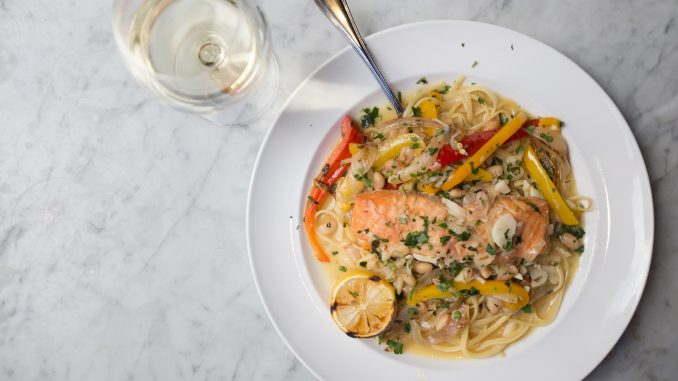
Barra Rossa, just down the street from the Walnut Street Theatre, is a frequent stop for foodies, theater-goers and wine enthusiasts.
The wine bar and pizzeria, located at 929 Walnut St., specializes in fresh Italian dishes and specialty pizzas, and offers an extensive wine list to pair with its dishes. For dinner this season, bar manager John Mann recommends pairing signature entree Salmon Toscana with either a “big” California chardonnay or a lighter red wine, like Pinot noir.
“There are some general guidelines you use to begin with,” Mann said of the pairing process. “The color of the flesh matches the color of the wine. The lighter it is, it will tend to go better with the white wine. Heavier, richer like beef, salmon, tuna … those proteins are going to go better with a richer, meatier wine, so we go to reds.”
Kristin Birch, a sommelier at Barra Rossa, said one of the most important pairing factors to consider is the acidity of the wine.
“With fish generally you think whites,” Birch said. “But with salmon, since it’s a meatier, more flavorful fish, you can definitely start getting into reds, especially the lighter-body reds. A really classic salmon pairing is Pinot noir. The acidity in the Pinot noir can definitely cut the fat content of salmon and hold up to its flavor.”
While the general rules of wine pairings are a good place to start, Mann said “you can mix and match” according to preference and the type of dish. Barra Rossa’s salmon dish, he said, is a good “in-between” dish when it comes to the type of wine to choose.
“It’s a cusp,” he said. “Like zodiac signs, when you say you’re a cusp, you’re a little of both. Heavier fish and lighter meats, they can be a little bit of either-or.”
Being in the restaurant business and constantly learning more about wine, Birch said, is enough to pique anyone’s interest in pairing.
Birch said, however, she really became interested in wine pairing when she was in college studying classics. She said that the study of wine is the intersection of geology, geography and history.
“People have been making wine for 5,000 years in some cultures,” she said. “So with wine, all the nuances of the environment of a specific area all go into the wine.”
These nuances include the specific minerals and flavors that ultimately make a certain wine pair perfectly with a given dish. Different grapes have natural flavors, Mann said, that can sometimes match spices in each dish.
“To use an analogy, chocolate and peanut butter,” Mann said. “Who thought that would work? But there’s things that just oddly pair together well.”
“[For the Salmon Toscana] in particular, you have the peppers and the light white sauce combined with the pasta that matches with the chardonnay very well,” Mann said. “On the other hand, the meatiness of the salmon matches very well with a lighter red wine like a Pinot noir. That’s why that dish in particular matches with both red and white wine.”
Mann said although there are traditional guidelines for pairing dishes with wine, cocktails are more independent from food and do not follow a similar pattern.
“Generally the habit you see is people will have a cocktail maybe before dinner, then ‘foodies’ will move to wine with dinner because wine has characteristics that pair with food on a much higher level,” he added. “A Jack and Coke doesn’t match really with much of anything unless you marinate your burger in Jack Daniel’s.”
Most people have a few favorite cocktails and stick to them no matter what they order for dinner, Mann said. He noted that most restaurant-goers are more likely to try a new variety of wine than a new type of liquor.
Although the general guidelines are a good place to start when pairing, Mann said they do not always have to apply.
“You like what you like and if it’s off the beaten path, so be it,” he said. “You have to kind of experiment a lot, too. Sometimes what I think is a perfect match, other people think it just doesn’t taste well at all. A lot of it is up to personal flavor profile.”
Erin Moran can be reached at erin.moran@temple.edu.


I every time spent my half an hour to read this weblog’s articles or reviews every day along with a
mug of coffee.